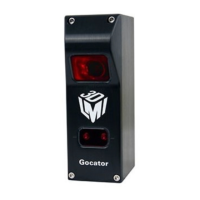Gocator Line Profile Sensors: User Manual
Gocator Web Interface • 193
To select a measurement, it must be enabled. See Enabling and Disabling Measurements on page 199
for instructions on how to enable a measurement.
4. Click on the Output tab.
For some measurements, only the Output tab is displayed.
5. Expand the Filters panel by clicking on the panel header or the button.
6. Configure the filters.
Refer to the table above for a list of the filters.
Measurement Anchoring
When parts that a sensor is scanning move on a transport mechanism such as a conveyor, their position
typically changes from part to part in one or both of the following ways:
l along the X, Y, and Z axes (basically, horizontally and vertically)
l around the Zaxis (orientation angle)
When the position and angle variation between parts is minor—for example, when scanning electronic
parts in trays—you can anchor one tool to one or more measurements from another tool to
compensate for these minor shifts. As a result, Gocator can correctly place the anchored tool's
measurement regions on each part. This increases the repeatability and accuracy of measurements.
For cases where movement from part to part is more drastic, you can use part matching to
compensate. However, in order for part matching to work properly, the entire part typically
must be visible in the field of view.
For example, the following image shows a surface scan of a PCB. A Surface Dimension height
measurement returns the height of a surface-mount capacitor relative to a nearby surface (the F1
region).
